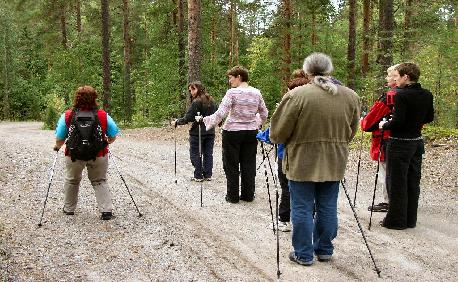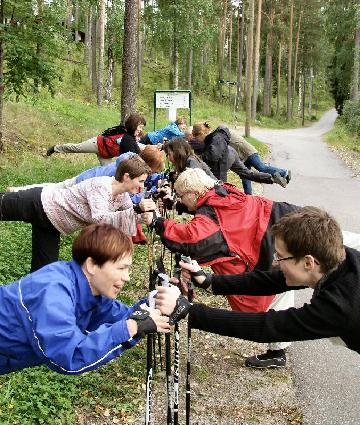Nordic Walking as an innovation in practice
We have written two articles about Nordic Walking, using this as a case with which to examine different aspects of innovation in practice

Shove, E. and Pantzar, M. (2005) 'Consumers, producers and practices: understanding the invention and reinvention of Nordic Walking', Journal of Consumer Culture, 5 (1): 43-64.
In this article, we develop the idea that innovations in practice are about making and breaking links between elements of material, image and skill. We suggest that such linkages are always local and that what looks like the 'diffusion' of practice is better understood as its successive (re)invention
Towards a theory of practice innovations:a discussion of the production and re-production of Nordic Walking.
Mika Pantzar and Elizabeth Shove (2010) Technology Analysis and Strategic Management, 22(4): 447-461.
Building on the work of those who have highlighted the role of consumers
and lead users we focus on innovations not in products but in what people
do. In developing a method of conceptualising the emergence and reproduction
of practice we argue that innovation is not a one-off moment but a continuous
on-going process. Specifically, we suggest that innovations in practice
involve changing combinations of symbolic and material ingredients and
of competence or know-how. In addition, we argue that managers, manufacturers
and consumers are all variously involved in making and sustaining connections
between these defining elements. We illustrate and elaborate on these
ideas with reference to Nordic Walking, a form of speed walking with two
sticks. First practiced in 1997, it is now a regular pursuit for more
than seven million people in over 30 countries and is reputed to be Europe's
fastest growing form of exercise. In discussing this case we specify the
constitutive ingredients of Nordic Walking and its location relative to
other practices that already exist. Our analysis raises a number of general
questions. For example, how can managers and manufacturers institutionalise
practices that require consumption of the things they make? Is there any
fundamental difference in the role of ‘lead’ and ‘ordinary’
users in generating and sustaining innovations in practice? Taking these
questions forward, we develop a theoretical position that relativises
the conventionally distinct roles of consumers and producers and that
represents a novel hybridisation of innovation studies and sociological
theories of practice.

Katja Oksanen-Sarela and Paivi Timonen's chapter (2005) 'Diversification of Practice - the case of Nordic Walking' in Pantzar, M. and Shove, E. (eds) Manufacturing Leisure examines similar sorts of dynamics